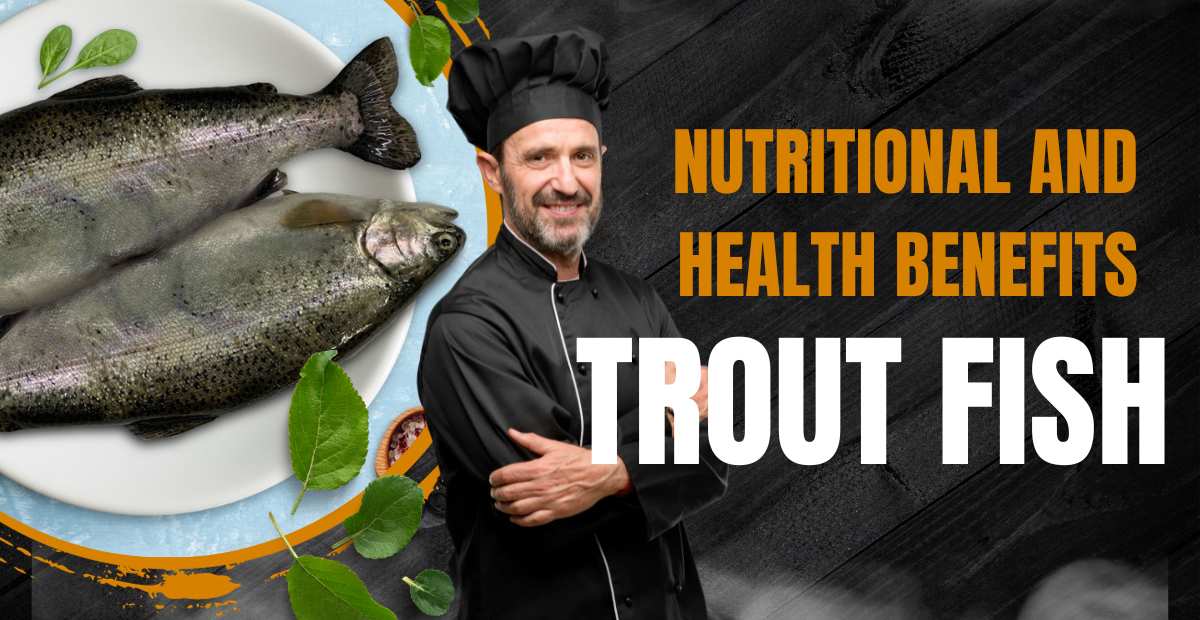Trout is a popular freshwater fish with beautiful, fragrant meat. Trouts prefer the cold waters of lakes and rivers, while some species live in the sea and, like salmon, return to freshwater to spawn.
Trout is a member of the Salmonidae family, which includes salmon, char, and grayling.
Several trout species live in Northern Hemisphere rivers and seas. Their meat is semi-fatty, fine, and flavorful. The exquisite flavour of trout varies slightly depending on the species. Their meat can also be white, ivory, pink, or reddish depending on the feeding features.
Several trout species live in Northern Hemisphere rivers and seas. Their meat is semi-fatty, fine, and flavorful. The exquisite flavour of trout varies slightly depending on the species. Their meat can also be white, ivory, pink, or reddish depending on the feeding features.
Brown trout, often known as European trout, has pink flesh that is delectable. The rainbow trout gets its name from the horizontal strip of colour on its metal-blue backsides that ranges from dark pink to vivid crimson.
Lake char, sometimes known as American char, is distinguishable from the other species by its longer body, which is frequently speckled with pale, sometimes yellowish patterns, and by its forked tail. Its colour varies.
Brook trout, often known as speckled trout, is a smaller species.
The beauty of its colorings distinguishes Arctic char, which is generally dark blue or blue-green on the back, silver-blue on the sides, and white on the belly. It has huge red, pink, or cream dots on the sides. Its size changes according to its environment.
When caught fresh, grayling has a thyme fragrance. Its entire body is flecked with a variety of lozenge- or V-shaped patterns. It is a lovely fish that can grow to be 16-20 in. (40-50 cm) long.
Description:
Trout are oily fish with similar external characteristics to salmon, such as a huge, elongated, oval body, a small head, small eyes, and a lower opening mouth that opens back behind its eye. The dorsal fin is speckled with huge iridescent red or purple dots on the body. The back is often dark, while the sides are iridescent grey, with big scales and a total of seven fins. Adult freshwater rainbow trout can grow to be 1-2 feet long and weigh up to 5-7 pounds, but migrating steelheads (anadromous forms) can weigh up to 20 lb (9 kg).
The life cycle:
Trouts return to their natal waters for reproduction, regardless of whether they live in fresh or salt water. To survive, tiny alevins and small fry require cold, clean, oxygenated water and largely feed on planktons, bug larvae, and other fish larvae.
Some coastal rainbow trout (steelhead) live in the ocean as adults but migrate to freshwater to spawn. The lifespan of trout fish varies greatly, ranging from 7 years for rainbow trout to 15-20 years for Lake trout (Salvelinus namaycush).
Habitat:
Trout is an emblem of the northern wilderness’s pure, icy streams. Some species live their entire lives in cold freshwater streams, rivulets, and small rivers. Anadromous trout species migrate from their natal freshwater streams, rivers, lakes, cold creeks, estuaries, open bays, and deep ocean waters back to their natal waters to spawn.
Trout Fish Health Benefits
Trout, being a semi-fatty fish, is low in calories; 100 g of fish contains only 149 calories, compared to 160 calories in salmon.
Trouts have a high protein content. Their lean meat contains 20.77 g/100 g (37% RDI) of protein and is rich in all necessary amino acids in balanced amounts.
Consumption of seafood may reduce the risk of heart attack, stroke, obesity, and hypertension, according to research. Seafood contains less saturated fat and more "heart-healthy" polyunsaturated fat, such as omega-3 fatty acids.
The American Heart Association suggests eating at least two servings of oily fish each week to meet your needs for critical fatty acids, protein, minerals, and fat-soluble vitamins.
Trouts of all species are high in vitamin A, vitamin D, and long chain omega-3 fatty acids (PUFA).
Trout, like other oily fish, is high in omega-3 eicosapentaenoicacid (EPA), docosapantaenoicacid (DPA), and docosahexaenoic acid (DHA) fatty acids. According to research, these fatty acids, notably DHA, have a crucial function in the development of the nervous system, particularly in infants and children.
According to Cornell University and the New York Sea Grant Extension Programme, these fatty acids can help decrease blood pressure and pulse rate while also improving cardiovascular function. For example, studies have indicated that omega-3 fatty acids lower the incidence of arrhythmias (abnormal heartbeats), which can result in abrupt death. Omega-3 fatty acids also lower triglyceride levels and inhibit atherosclerotic plaque development.
Several big trials in adults have looked at the effect of fish or fish oils on heart disease. Heart attack survivors who took a 1-gram capsule of omega-3 fats every day for three years were less likely to suffer a second heart attack, stroke, or die of sudden death than those who received a placebo in the "GISSI Prevention Trial."Niacin, vitamin B6, vitamin E, vitamin B12, thiamin, and riboflavin are among the vital vitamins found in trout. Furthermore, because trout is an oily fish, it has high levels of vitamins A and D.
In comparison to salmon, trout has a low level of Vitamin A (57 IU/100g). Vitamin A and omega-3 fatty acids are required for healthy mucosa and skin.
Trout flesh is lower in vitamin D (155 IU/100 g) than salmon flesh (526 IU/100 g). Vitamin D is essential for calcium metabolism and provides cancer prevention.
The Food and Drug Administration (FDA) recommends that pregnant women consume at least 8 ounces (340 grammes) of low-mercury seafood every week.
Trout is an excellent source of minerals such as calcium, zinc, potassium, phosphorus, and magnesium. It is also a good source of iodine.Buying
Trout can be purchased fresh or frozen, whole, trimmed, filleted, and occasionally in steaks. It is also available in smoked, salt-cured, and canned varieties.
Purchase high-quality seafood from reputable vendors. Purchase a complete trout side or a fillet from the thickest part of the fish. Wild-caught trout will have pinker and more vibrant flesh than farmed fish. Wild fish are more nutritious and contain less contaminants than farmed fish. There have been reports of artificial colorants/dye being used in farmed trouts to make them look like pink, wild trout.
Products similar to salmon can be found in stores, such as ready-to-cook pâté, kabobs, marinated and peppered trout steaks and fillets, salted trout, and burgers.
Avoid trout fish with a strong amine odour, just as you would avoid salmon. Smoked trout with leaky and damp margins should be avoided.
Because the meat of trout is fatty and attracts bacteria, it degrades quickly. Fish fillets/sections should always be kept in a deep freezer.
Preparation
To avoid masking the delicate flavour of trout, prepare it as simply as possible. Smoked trout is delectable. All salmon dishes are also suited for trout.
The skin scales can be left on. The fillets are simple to remove. The meat of the trout near the head is more delicate than the flesh near the tail. If you prefer to skin it, simply peel it from the inside out. Before cooking, remove any bones.
All salmon dishes are also suited for trout. Trout can be pan-roasted, shallow-fried, broiled, foil baked, or grilled to make a number of delectable dishes. Just be sure to cook it until the meat is opaque and readily flakes off.
Here are some serving suggestions:
Trout, like salmon, is used to make sandwiches, salads, omelettes, pasta meals, mousses, and quiches.
As an appetiser, smoked fish is served with capers and cream cheese.
For an hour, marinate whole fish in lemon slices and herbs (minced garlic, thyme, parsley, peppercorns, etc.). Then bake or grill until done, and serve with lemon wedges.
Mousse, soufflés, pâté, and crepes are all made with canned fish. It is used as a spread on sandwiches and canapés.
Ikura is a crimson caviar prepared from the roe of salmon, trout, or cod in Japan. In Japan, it is used in sushi and rice dishes.Profile of safety
Farmed trout may contain polychlorinated biphenyls (PCBs) and antibiotics, both of which are toxic to humans. There have also been proven reports of artificial colours being put into fish flesh to make it appear pink.
Because trout is a seafood, it may include microorganisms such as parasites, germs, and viruses that can cause foodborne disease. To avoid foodborne illness, it is critical to handle fish safely.

